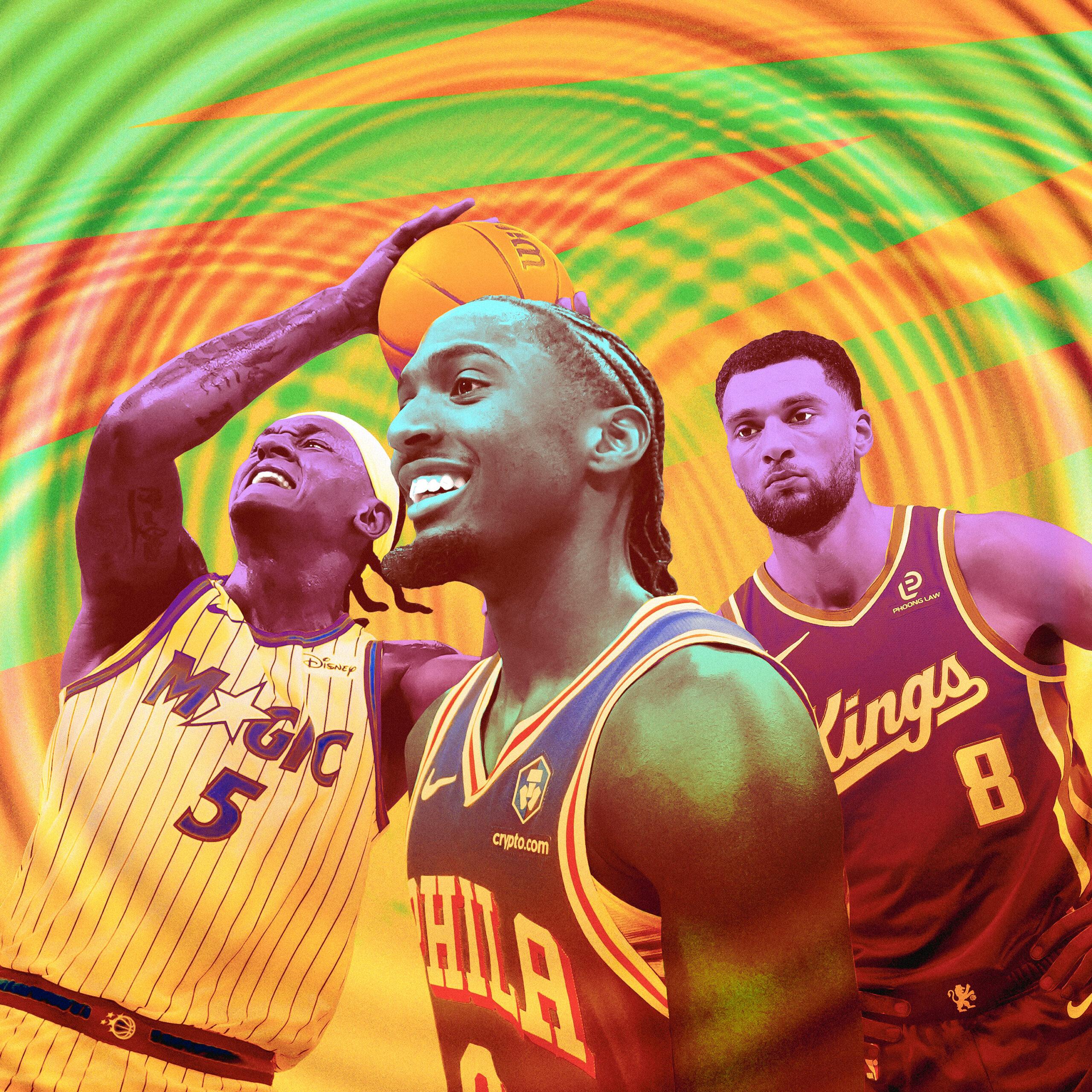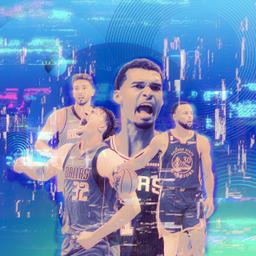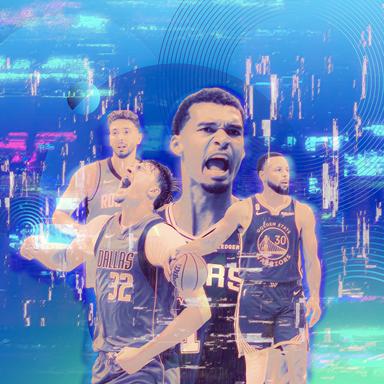
The first two weeks of the NBA season might be an unreliable fortune teller for this spring, but they can tell us a whole lot about how close a team’s offseason expectations are to its in-season reality. This early on, when everyone is just glad basketball’s back, it’s all about building momentum and good vibes. So let’s check in on the vibes for five of the most surprising teams from all across the spectrum, from good to bad to … ???
Philadelphia 76ers: A Backcourt to Believe In
Philly’s off to its best start to a season in six years and has been the NBA’s early comeback king—emerging as one of the biggest surprises after a near-apocalyptic 2024-25 season and somehow already going 3-0 in games where the Sixers had a double-digit deficit in the fourth quarter.
While last season was defined by the overbearing weight of injuries and unmet expectations, maybe the best way to describe the Sixers this year is untethered. Joel Embiid is going to play when he’s going to play, but his presence (or lack thereof) no longer feels like a psychodrama threatening to block out the sun. Instead of focusing on their felled transcendent talent, they’re leaning into joy and the advantages they have in the present. Namely, the backcourt, which is marked by irrepressible athleticism. Tyrese Maxey is arguably the fastest player in the league when he has the ball in his hands; VJ Edgecombe is a rookie who I compared to Kentavious Caldwell-Pope bitten by a radioactive spider last spring.
Maxey has been a revelation, leading the league in scoring and marking the culmination of all the different roles he’s been in across his five years with the team. His pull-up game has never looked better. The touch on his floater is downright supernatural. And even though he has more on his plate offensively than ever, he’s more than happy to fall back into his role as the back-cutting beneficiary of an Embiid two-man game. Where his speed used to be expressed with a sort of flowing, tai chi–esque grace, there is a whole lot more punch this season. He spent the summer working on initiating and finishing through contact, and that extra physical edge has permeated through the rest of his skill set. He’s scored 150 points across his first four games, which puts him in commune with the greatest Sixers of all time: Only Wilt Chamberlain, Allen Iverson, and Embiid have had more prolific four-game stretches in Philly.
That Edgecombe already looks like a potent release valve from deep isn’t a shock—he was an excellent spot-up shooter with his feet set at Baylor—but it was the occasional self-creation flashes in college that seemed like his portal to stardom. Those flashes have transitioned seamlessly into the NBA. One of the common hurdles for an athlete of Edgecombe’s caliber is synchronizing body and mind. Thus far, the 20-year-old hasn’t looked as sped up as he did at times at Baylor; his fluidity and patience have been surprising. Those early signs of self-possession have given the Sixers a green light to explore his talents in high pick-and-rolls, even with Maxey on the floor alongside him.
The vibes are better in Philly than anyone could have foreseen, even if there are some legitimate concerns amid the team’s undefeated streak. For starters, maybe don’t fall behind by double digits to the Hornets and Wizards in the fourth quarter. There’s also the question of how much the team is relying on its starting backcourt early in the season. Maxey’s averaging a league-high 43 minutes per game, which would be the highest single-season average since Monta Ellis’s 40.3 minutes per game in 2010-11 (coincidentally, Edgecombe is averaging 40.3 minutes per game through four games). With Tom Thibodeau out of the league, Nick Nurse has taken the mantle as the coach most likely to grind his players into dust. While it isn’t necessarily a sustainable long-term strategy, the Sixers’ deployment of Maxey and Edgecombe proves that they finally have the horses to run. There might not be any harm in getting a head start with the return of Jared McCain and Paul George on the horizon.
Chicago Bulls: A Strange Vision of Utopian Hoops
There is a spark of delightful absurdity in these Bulls that’s not unlike when a comedian beats a dead horse with a joke, only for it to become riotously funny again the ninth time around. The Bulls are somehow extremely exciting so far, in large part because they haven’t been legitimately exciting in years. The general basketball public has penciled the Bulls in for 39 or 40 wins for what feels like the past decade, largely because of an institutional malaise. Why get your hopes up for an organization that has consistently signaled to its fan base that the bottom line will always matter more than winning?
But dating back to last season, there were signs that the roster’s identity was shifting internally. Finally trading away long-suffering star Zach LaVine before the deadline last season created new stylistic avenues. Having seen the kind of force-multiplier effect that Lonzo Ball once had on the last shockingly good Bulls team in 2021-22, last season the team seemed to build itself back up around the synaptic, instinctual playmaking of Josh Giddey. The Bulls played frenetically, which suited the hard-charging audacity of their young star-to-be Matas Buzelis just fine. And they’ve carried that into the new season with aplomb.
It shouldn’t work, but it does. The Bulls have increased their pace from what was already a league-leading number of possessions in the second half of last season. They have the third-highest assist rate in the league and the third-lowest defensive rating. Between an emphasis on spacing, a heavy reliance on creating transition opportunities, and two point guards in Giddey and Tre Jones who excel at whipping out passes in motion, the Bulls force defenses to guard every inch of the floor. Nikola Vucevic’s time with the Bulls may outlast us all, but given his particular skills as a 3-point shooter, defensive rebounder, and high-post playmaker, he’s an integral part of the system. They play damn near their full rotation, with an endless procession of athletic perimeter defenders and just enough capable shooters to maintain consistency across all possible lineup configurations. The Bulls are getting it done through their insistent style—and they’re getting it done without Coby White, the closest thing to a star Chicago has on the roster, who has been recovering from an offseason calf injury.
There will (rightfully) be plenty of skepticism to come regarding the sustainability of the Bulls’ success, but I’d rather consider how this surprising run might be emblematic of leaguewide trends. The Bulls’ lack of top-end talent may eventually cap their ceiling, but there are games to be won purely with depth, chemistry, and all-out effort.
Dallas Mavericks: Point Guarding Ain’t Easy
Cooper Flagg has historically been a slow starter. But there are few players his age with the same capacity to adjust. By the end of Flagg’s freshman year at Duke, he looked every bit the part of a can’t-miss no. 1 prospect, but his first seven games were relatively lackluster. Flagg also had a woefully inefficient summer league debut before erupting for 31 points in Game 2. Rookie seasons are full of peaks and valleys, and Flagg has certainly not been immune. He followed up a 22-point performance against the Raptors earlier this week with a two-point outing against the Thunder (wholly understandable given the miles-wide chasm between the two teams in terms of defensive congruence).
It’s all part of the experience for an 18-year-old being asked to play a position he’s never played before at the highest level of competition he’s ever faced. The Mavs have thrown Flagg into an 82-game Danger Room in hopes of extracting transcendence from their prodigy in what increasingly feels like a gap year. Cooper’s long-term development as a playmaker has been head coach Jason Kidd’s primary focus since the draft. “Cooper Flagg’s in intense point guard boot camp” is a gripping headline and probably good break-room fodder, but the positionality of it all seems tangential to the actual development goal. Flagg won’t be the player who ultimately determines whether point guard is a position of nature or nurture. The Mavs are assessing his capacity as a problem solver, given his track record of year-over-year growth.
Dallas can live with Flagg fumbling the ball away against active hands at the point of attack if it means he gets lower on his dribble the next time around. The Mavs will give him a pass for jumping too far outside the restricted area on a high-velocity drive since they know that basketball is a game of calibration. There are already flashes of what he’s capable of doing when he draws multiple sets of eyes to the ball:
Dallas is trying to hone Flagg’s instincts and expand his affordances under the highest levels of pressure and scrutiny. Hopefully, one day, the game will be rendered at 0.5-times speed through Flagg’s eyes, but in the meantime, he’ll have to manage the frustration of feeling sped up, of doing too much.
Sacramento Kings: Exactly as Confounding as They Look
“We probably should be 4-0, but we’re not ready to be 4-0.”
We’re less than two weeks into the season, and Kings head coach Doug Christie is delivering Mr. Miyagi lines to the media. But he isn’t exactly delusional. Sacramento had a fourth-quarter lead in each of its first four games this season. An eternal optimist would point out that the now-immortal “Light the Beam” Kings of 2022-23 lost their first four games before turning in the third-best record in the West by season’s end.
But all the consternation surrounding the Kings feels more existential than a response to a poor start. It certainly isn’t about any one player—the Kings have certified bucket getters up and down the roster, and the team will inevitably be involved in trade talks closer to the deadline. The issue is more systemic. At best, the team has zero rim protectors on the roster, and it showed against the Bulls on Wednesday night. Domantas Sabonis is a good NBA center. But he cannot, in any conceivable universe, anchor a team that is also starting DeMar DeRozan, Zach LaVine, Russell Westbrook, and Dennis Schroder. Sacramento allowed the cleanest shot diet imaginable against Chicago: 70 of the Bulls’ 126 points came from within the paint; the rest were from behind the arc or from the free throw line. It’s hard to win when you’re conducting layup lines for the bulk of a game.
The team isn’t without intrigue, although it might be more accurate to call it morbid curiosity. I’d be lying if I said I’ve never wanted to see what it’d be like to watch Westbrook play power forward in a game, but the fact that the Kings’ roster is structured in such a way that requires Russ to play the 4 on back-to-back nights suggests something woefully amiss, injuries be damned. A starting lineup with four on-ball scoring guards and an undersized post-hub center is some twisted thought experiment I would have cooked up as a teenager in NBA Live 2005, but it’s not a viable reality in 2025. It’s not quite as galaxy brained as Kings owner Vivek Ranadive’s 4-on-5 cherry-picking defense concept, but it’s close.
Orlando Magic: “I Thought It Was Gonna Be a Hit!”
At this point, the Magic may be perpetually cursed to finish annually as one of the league’s worst 3-point-shooting teams, no matter what offseason additions they make. Since the 2012-13 season, the team has consistently been in the bottom third of the NBA in 3-point percentage. Only once in the past 13 seasons have the Magic shot the 3-ball at a clip better than league average. That happened in 2018-19, when the league average was 35.5 percent; Orlando shot 35.6 percent.
It’s not for lack of trying! But investing draft capital in shooters like Caleb Houstan and Jett Howard hasn’t worked, and higher-profile offseason acquisitions haven’t quite fixed the problem, either. Kentavious Caldwell-Pope had shot 38 percent or better from 3 in five consecutive seasons before joining the Magic last season, when he saw his accuracy dip to lows he hadn’t had in nearly a full decade. He (along with, famously, four future first-round picks) was then traded to the Grizzlies for Desmond Bane, who has shot better than 40 percent from deep across his career. After five games, Bane is currently shooting 26.9 percent from 3.
Then again, perimeter shooting might be the least of Orlando’s worries. The Magic shot 38.7 percent from deep on Wednesday night against the Pistons. They still lost by 19. The team looked like offseason winners, having shored up a 3-point-shooting weakness while building on a sturdy foundation. But five games in, it’s not quite clear what exactly the team has left to hang its hat on.
It’d be less glaring if the Magic’s characteristically elite defense were still intact. In the Jamahl Mosley era, the Magic had been able to rely on coverage built around their tenacity and size advantages up and down the rotation. But an offseason mandate to play a bit faster and looser on offense has led to a medley of miscues. After being in the bottom five in pace over the past two seasons, the Magic have jumped out to a top-10 pace this season. “That's kind of what you give up when you speed the pace up,” Paolo Banchero said after the team’s 136-124 loss to the Sixers on Monday. “Teams are able to get out and run, and it causes cross-matches and miscommunications.” The 136 points they allowed to Philly was the second-highest score the Magic have given up since 2023-24 (the Kings dropped 138 on them in 2024, but that required two overtimes). Two nights later, they allowed 135 to the Pistons.
The Magic are also trying to find an appropriate balance for their offense, but it’s hard to imagine a world in which a precipitous decrease in touches for Franz Wagner accomplishes whatever goal Mosely has set out to achieve. (For reference, players like Grayson Allen, P.J. Washington, and Donte DiVincenzo are all currently averaging more touches per game than Wagner, who played like a borderline All-Star last year.) For a team struggling to find rhythm in the half court, Orlando has yet to fully realize the perks of having two enormous star forwards serve as its most trustworthy playmakers. Simply involving Wagner—who makes snap decisions while hardly turning the ball over—ought to open things up from a drive-and-kick standpoint.
One thing I’d been curious about all offseason was the potential of a Banchero-Bane inverted pick-and-roll, a pet play that has done wonders for players like Nikola Jokic and Giannis Antetokounmpo. At his size, there is no reason Banchero can’t leverage his on-ball gravity in a similar manner to free Bane up for easy looks. Monday offered a faint glimmer:
Not the most streamlined execution, but the intent is there. The vibes are in the dumpster after two weeks, but the Magic know as well as anyone how long the season is. This time last year, they looked like they were well on their way to being dark-horse title contenders. These early weeks are for identifying pressure points and establishing a proper hierarchy. But it’s not as easy to fix an issue when the issue appears to be everything.









